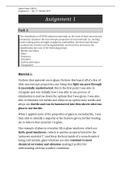Sydnee Brain 193024
Assignment 1 – Due 11th October 2019
Assignment 1
Task 1:
The classification of FOUR unknown materials on the basis of their macroscopic
properties. Examine the macroscopic properties of each material (i.e. melting
point, boiling point, strength, toughness, malleability, electrical and thermal
conductivity, density and biodegradability) and from this determine the
classification into one of the following groups:
- Metals and alloys
- Glass
- Polymers
- Ceramics
- Carbon allotropes
- Composites
Material 1:
I believe that material one is glass, I believe this based off of a few of
their macroscopic properties; one being that light can pass through
it essentially unobstructed, this Is the first point I was able to
recognise and was initially how I was able to use process of
elimination to narrow down the options that I was given. I was also
able to eliminate out metals and alloys as an option since metals and
alloys are ductile and can be hammered into thin sheets whereas
glass is not ductile.
When I applied more of the properties of glass in everyday life, I was
then able to identify a majority of the features given, further leading
me to believe that material 1 is glass.
One example of glass in everyday life is glass windows; which are
fairly good insulators, (which is another property listed for the
‘unknown material 1’) and keep the heat inside of a room despite it
being cold outside, glass windows are also resistant to most
chemical corrosion and abrasion-making it perfect for
withstanding extreme weather conditions.
, Sydnee Brain 193024
Assignment 1 – Due 11th October 2019
To further support my conclusion, I also applied a few properties to a
glass bottle; glass bottles act like plastics when molten and set. (This
is because of glass’ high melting point)
Furthermore, glass bottles are brittle and will shatter rather than
dent when hit with enough force, i.e. from a hammer, or dropped
onto a hard surface, this is due to the random arrangement between
the particles,
Material 2
I believe that the classification of material 2 is metals and alloys.
Similarly to glass, metals and alloys are not malleable and are
extremely stiff. However, unlike glass, metals and alloys will bend
rather than shatter due to the lattice-like structure of metal ions,
allowing metals to bend without breaking. Metals are ductile and
can be shaped into wires and can be hammered into thin sheet.
Metals and alloys are also opaque because they have metallic
bonding and so all of the atoms are surrounded by free moving Delocalised electrons
electrons, therefore, any light that passes through a metal will hit one
of these electrons which will absorb the light and re-emit it.
Additionally, metals can conduct
electricity because the ions can move
throughout the sea of delocalised
electrons.
Metal ion in fixed position
2




